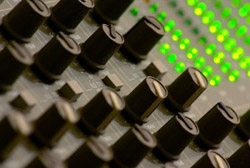Recently I had a chance to sit in on a seminar given by Kent Morris.
Kent’s a brilliant guy. He works with Peavey and focuses on training churches on sound systems and how to use them. The topic of the seminar was how to use multiple microphones in a live situation.
What really captured my attention was something Kent said about EQ.
He was talking about how to EQ a vocal to bring out clarity and definition when he made the following statement:
“Every instrument you deal with has a fundamental frequency in the 250—500 Hz range.”
The dictionary on my Mac defines fundamental frequency as “the lowest frequency produced by the oscillation of the whole of an object, as distinct from the harmonics of higher frequency.”
What does that mean? Let’s say I’m singing an A note. 440 Hz is the fundamental frequency of that note, but that’s not the only frequency present. The sound of my voice is made up of that fundamental frequency combined with a complex mixture of harmonics at higher frequencies. These higher frequencies are what we use to differentiate my voice from another voice singing the same note.
Or let’s say a piano and an acoustic guitar play the same note. The reason we can tell the difference is because the harmonic content of each instrument gives the instrument its timbre.
To review, the fundamental frequency defines the pitch, while the harmonic content defines the tone of a sound.
So what does Kent’s quote have to do with us? Well, when mixing a song, we’re combining a bunch of tracks. If the fundamental frequency for each of these tracks is somewhere between 250 Hz and 500 Hz, then we’re obviously going to have a huge build-up in that range.
This, ladies and gentlemen, is where the mud comes from. You know what I’m talking about. Each track you recorded sounds amazing when you solo it, but then when you bounce a mix of everything, it’s all muddy and cluttered, and it gives you a headache. (I’ve done mixes in the past that literally give me an instant headache…sigh.)
Dealing With The “Mud Range”
So how do we take this information and put it into practice? Here’s my advice: next time you’re mixing, and things are sounding muddy, don’t immediately reach for the high frequency EQ knob and turn it up. Instead, spend some times cutting out some of that low-mids.
It’s been said many times, but I’ll reiterate it here. EQ is meant to be a corrective tool more than it’s meant to be an effect. Removing problem frequencies (doing an EQ cut) is almost always more effective than boosting other frequencies.
The easiest way to do this is to take one of your EQ bands in the low-mid area and do a big boost. Next, sweep the frequency up and down until you find where the “mud” is coming from. (I have a sneaky suspicion it’ll be between 250 and 500 Hz.) Once you find the frequency, turn the gain down until you’ve done about a 3 dB cut and take a listen.
Oftentimes a 3 dB cut is all it takes to clear things up. Use more or less as you see fit, and hopefully there will be much less mud in your future.
To learn more about how to manipulate your tracks with EQ for both good and evil purposes (muahahaha), head over here: www.understandingEQ.com
Joe Gilder is a Nashville-based engineer, musician, and producer who also provides training and advice at the Home Studio Corner.Note that Joe also offers highly effective training courses, including Understanding Compression and Understanding EQ.





















